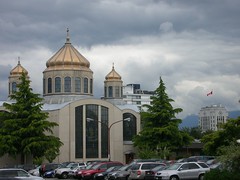Since the CPR's first passenger train arrived in the new city of Vancouver in 1887, transportation projects both grand and mundane have shaped this city. Logically enough, land value tends to increase as real estate becomes more accessible. When electric streetcar lines radiated out from Vancouver's central city into suburbs like Mount Pleasant and Point Grey, densification of land use along the lines followed, forming "commercial ribbons". Walter Hardwick's 1974 book "Vancouver" shows a photo from 1909 of the 4th Avenue streetcar's first run through Point Grey. Streetcar tracks run down a rough road cut through the trees. The only other visible signs of development are overhead wires and streetlights. What are now Vancouver's central neighbourhoods were initially opened up to development by streetcars.*
Here we go again in the 21st century. As the Canada line improves accessibility between downtown Vancouver, central Richmond and the airport, the built landscape as well as the character of neighbourhoods will be affected along the line. One result is bound to be overall increased density. So far construction has reduced access to areas like the Cambie Village on a temporary basis while land values may already be undergoing anticipatory inflation based on future accessibility.
*If you've ever wondered, the little jog in the commercial strip where Broadway meets Alma St. exists because two streetcar lines (Broadway and 4th Ave) once met there before the tracks followed 10th avenue further west.





1 comment:
This posting of yours reminded me of down-town east side. That how with the closer of tram (also opening of Eatons store) caused the Woodward store to close and which led to vicious circle of the east side being east side.
But I was also thinking from governtments point of view, the time we live in is where we get to hear all the time "time is money" and in order for us to have more money is wise use of time. And travel time is considered to be wasted time. So in order for government to provide city with faster traveling facilities RAV line was the solution. But it also is to serve the tourists coming to Vancouver. Considering tourism is one of the important part of Vancouver economy.
So in order to enhance that side of economy (hoping will be long term and fruitful investment) on the short term smaller business as you mentioned on Cambie street are being effected. I wonder if short term inconvenience is better than future long term inconvenience. Of course it is easier said than done. But at the same time government should have been considerate with the business on the street and give them some sort of compensations.
BTW do you know if anything of such nature is being done by the government?
Post a Comment